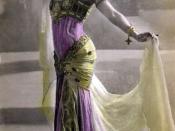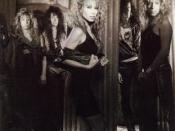The revolution was led by the women of the 1920's who grew exasperated of being viewed as drab monotonous housewives. They became increasingly sexually defined, more forthright and dominant, and spawned the image of the femme fatale. It originates from the French "fatal woman" meaning one who utilises the malign power of her sexuality to ensnare men.
Painted in 1530, Lucas Cranach's Salome epitomizes the figure of a femme fatale. Salome was once called upon to dance for King Herod who was very much entranced by her charm and grace. So much so that the king promised her anything she desired, upon which she requested the head of John the Baptist. King Herod was so infatuated with her that he immediately complied.
As Cranach illustrated, Salome possessed an extraordinary beauty and embodied the perfect woman, innocent and pure. She is seated, her hands clutching a silver platter which bears the severed head of John the Baptist.
Her surroundings create a striking contrast with her demeanour - she is proudly displaying the Baptist's head, her facial expressions pleasant and beguiling.
The background, painted in bleak desolate colours, allows a subtle hint to the underlying darkness of Salome. Contrary to other femme fatale texts, Cranach's portrait differs in that it displays both Salome's charm and allure but also her fatalistic qualities, through the texture, colours and main focus features of the portrait. The painting does not target a specific audience, but appeals to a more general one,
though an educated understanding of the femme fatale and the legend of Salome is needed in order to fully comprehend and appreciate it.
Dante Rossetti's "The Orchard Pit" describes another femme fatale. It details an ethereal encounter between a travelling man who is tempted by a beautiful woman. She draws men in...


